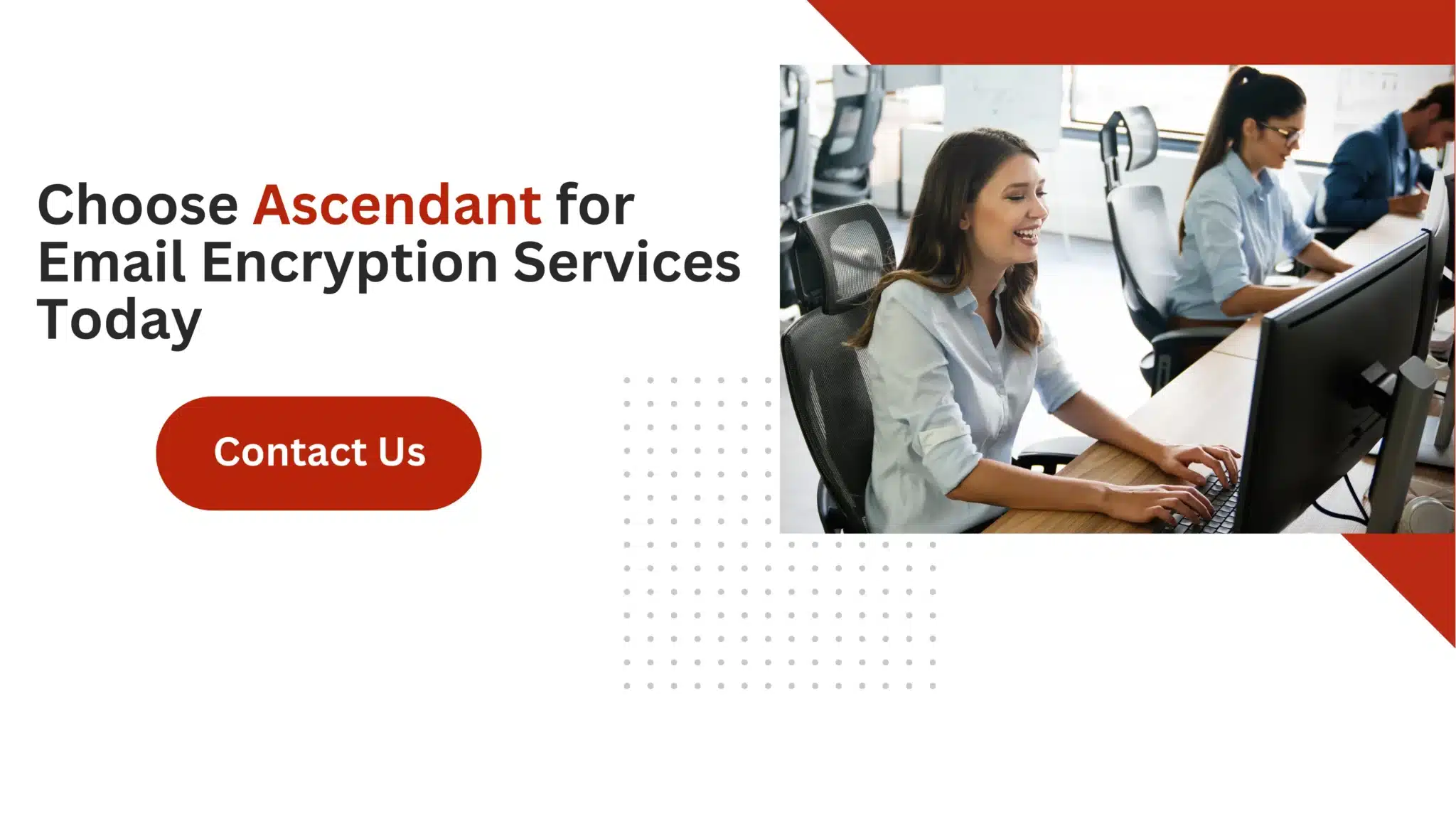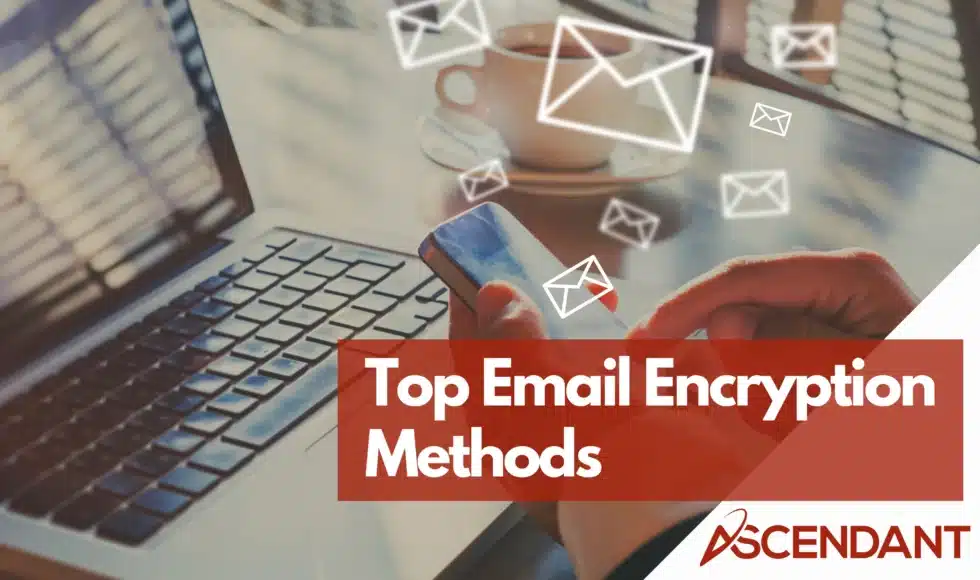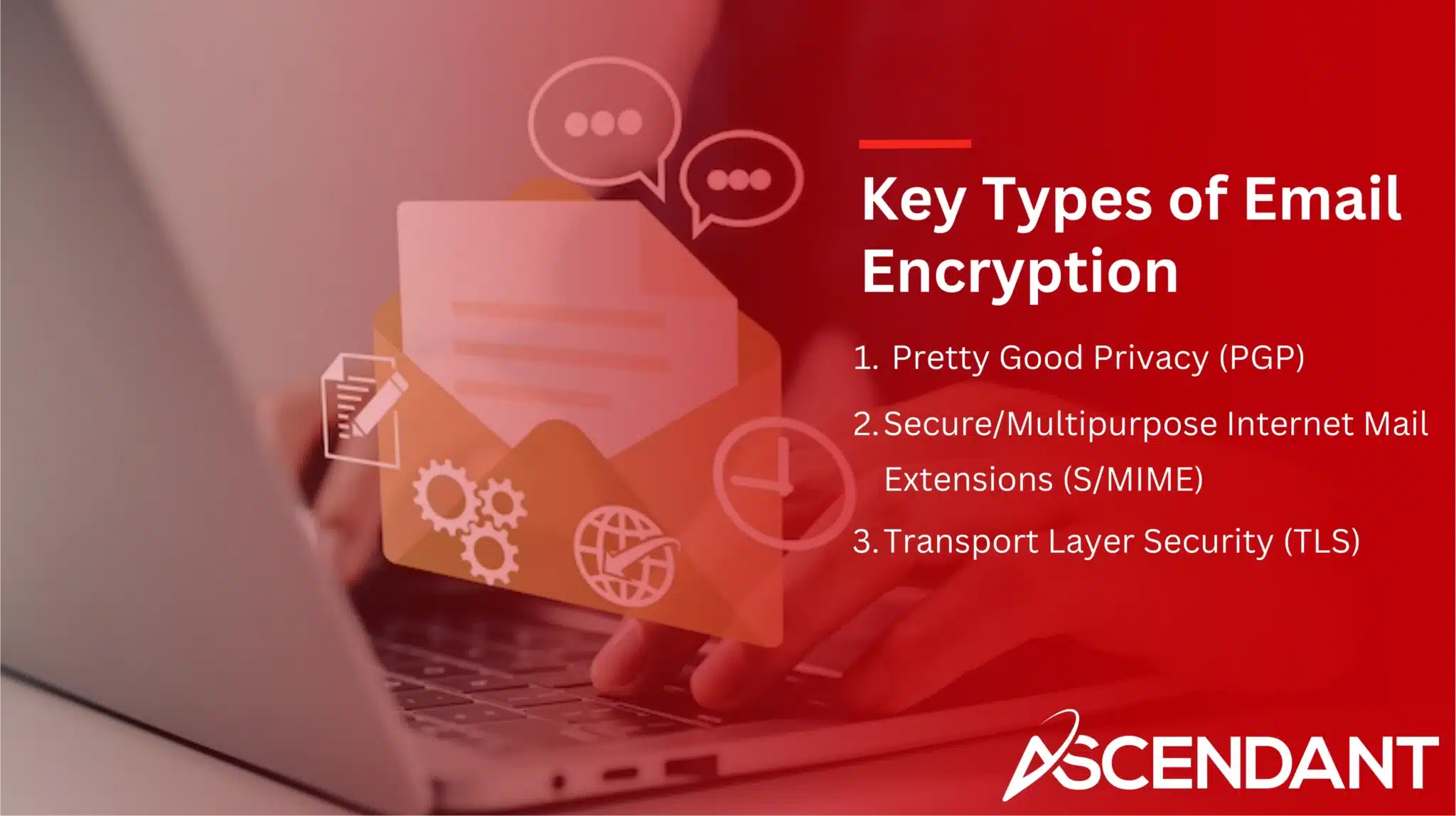Email encryption ensures your emails are readable only by the intended recipient, protecting sensitive data from cyber threats. It’s essential in preventing unauthorized access and data breaches. In this article, we’ll explore the best email encryption methods and how they can secure your communications.
Key Takeaways
- Email encryption transforms messages into an unreadable format, protecting sensitive data from unauthorized access through methods such as PGP, S/MIME, and TLS.
- Implementing email encryption services enhances compliance with data protection regulations and mitigates risks associated with data breaches and identity theft.
- Best practices for email security include using strong password protection, avoiding phishing attempts, and conducting regular security audits to maintain effective communication security.
Understanding Email Encryption
The process of email encryption utilizes authentication to convert an email message into a scrambled cipher text, designed so that only the intended recipient is able to decipher and read it. This method plays a crucial role in securing sensitive information such as personal identification details and financial data against unauthorized access. An encrypted email serves as a vital component within this security mechanism.
In the absence of encryption, emails are sent in clear text form, which leaves them exposed to potential interception and subsequent theft of information. Such vulnerabilities can lead to serious consequences including identity fraud or breaches of confidentiality. By employing an email encryption service, both messages being sent out and previously encrypted messages remain protected from cyber threats or violations involving sensitive data.
Encryption for secure emails typically involves protocols like SSL/TLS & STARTTLS, employed widely across communication platforms to preserve privacy during transit by encrypting contents beforehand. Thus presenting considerable challenges for any malicious actors attempting to eavesdrop on conversations. Modern services related to email software now provide more convenient cloud-based options along with web interfaces that facilitate easy usage and control over these secured communications without necessitating complex installations.
Within organizations where there is frequent handling of delicate content via electronic mailings, policy-guided measures are taken up ensuring automated encryptions apply specifically to those needing strict confidentiality—effectively rendering them into unreadable cipher texts accessible solely by verified recipients with authorization rights.
Key Types of Email Encryption
Securing sensitive data transmitted via email can be achieved through three principal encryption methods: Pretty Good Privacy (PGP), Secure/Multipurpose Internet Mail Extensions (S/MIME), and Transport Layer Security (TLS). These protocols each provide distinct advantages and are suited to a variety of situations based on individual needs.
Pretty Good Privacy (PGP)
Pretty Good Privacy (PGP) provides cryptographic security and confidentiality for digital communications. It employs a hybrid of symmetric-key cryptography, public-key cryptography, hashing algorithms, and data compression techniques to secure the transmission of data. In this process, when a sender wishes to send encrypted messages using PGP, they make use of the intended recipient’s public key. This ensures that only the individual with the corresponding private key is able to decrypt and access the message content securely – an approach known as end-to-end encryption – which shields sensitive or confidential information from unauthorized interception.
Despite its robust security features, PGP can sometimes be complex and not particularly user-friendly—a potential obstacle for some individuals. Within PGP operations lies Public Key Infrastructure (PKI), which underpins efficient management of necessary encryption keys along with verification certificates required for protected exchanges online. These certificates are issued by Certificate Authorities (CAs), verifying each party’s identity thereby fortifying communication against breaches in security.
Secure/Multipurpose Internet Mail Extensions (S/MIME)
S/MIME serves as a standard established by the IETF for employing public key encryption and digital signatures to secure email exchanges. In order to utilize S/MIME, one must acquire keys from a Certificate Authority that provides the essential encryption keys along with digital signatures. Such measures guarantee that sensitive information within an email can only be decrypted and accessed by its intended recipient, thus preserving confidentiality.
To ensure the robustness of S/MIME encrypted communications, it is imperative that both sender and intended recipient safeguard their private keys vigilantly. This security method proves particularly indispensable in business contexts where there’s a need to exchange sensitive data securely, assuring emails remain confidential and shielded against illicit intrusion or access.
Transport Layer Security (TLS)
Transport Layer Security (TLS) provides a means to transmit email data securely, safeguarding it from interception as it travels. As the successor of Secure Sockets Layer (SSL), TLS is extensively employed for maintaining both confidentiality and integrity of information across networks. An important feature incorporated in TLS is the STARTTLS command, which serves to upgrade non-encrypted communications into encrypted ones, bolstering security measures.
The majority of email applications come equipped with built-in support for TLS encryption by default, offering an effortless solution for secure online communication. Unlike some other forms of encryption where recipients may have additional steps to access messages, emails secured through TLS can be seamlessly read without extra action required on their part. Nevertheless, achieving end-to-end encryption typically requires more complex setup processes beyond basic configuration.
How Email Encryption Works
The process of email encryption is designed to ensure that an encrypted message remains confidential, with the content only accessible by the intended recipient. It utilizes sophisticated mathematical algorithms that form a link between public and private keys.
In cases such as end-to-end encryption, the sender uses the intended recipient’s public key to encrypt their message. Consequently, this message can be decrypted only with the possession of corresponding private key held by that particular recipient—safeguarding encrypted emails from being deciphered or intercepted by any unauthorized individuals.
Public Key Infrastructure (PKI)
The Public Key Infrastructure (PKI) serves as an essential framework that enables the management of public-key encryption, vital for safeguarding email communication. PKI plays a key role in facilitating the encryption process by overseeing the distribution and administration of necessary keys to encrypt emails securely. Its function extends beyond just key management. It also verifies identities and preserves confidentiality across digital communications, positioning it as a cornerstone technology in email security.
For secure S/MIME encrypted email exchanges, users must obtain unique keys from a Certificate Authority. Modern email clients come equipped with this feature. Take Apple Mail on iOS as an example—it incorporates S/MIME support directly within its system, eliminating the need for additional certificates when communicating with users sharing the same Exchange network.
Employing encryption for emails on iOS devices outside such networks requires manual installation of relevant encryption certificates tailored to each intended recipient’s information.
Encryption Protocols
Utilizing encryption protocols like TLS and SSL helps safeguard message transfers across networks, maintaining the confidentiality of communications. SSL ensures that data integrity is upheld by applying digital signatures to data, whereas TLS engages in a handshake process that establishes a secure connection prior to any data exchange. This handshake verifies the identities involved on both ends and generates a mutual secret key for protected communication.
STARTTLS is an imperative protocol which escalates unencrypted messages into encrypted ones, thereby strengthening security measures. In the absence of these encryption standards, emails stand at risk of being intercepted or stolen while in transit. Such protocols are indispensable for secure email exchanges as they render any seized emails indecipherable – this obscurity extends not just to the content but also to associated metadata. Making it challenging for unauthorized parties to interpret them.
Choosing an Email Encryption Service
Selecting an appropriate email encryption service is crucial for ensuring privacy and safeguarding against unauthorized breaches. When choosing such a service, it’s important to take into account the overall needs, regulatory compliance standards, and organizational scale that might affect your choice. A notable consideration is that various encryption services necessitate users to alter their current email addresses. This could entail a considerable shift for both individuals and companies.
Services offered by providers such as ProtonMail and PreVeil are designed with ease of use in mind without compromising on security levels. Leading email encryption services frequently incorporate capabilities like revoking access permissions and restrictions on forwarding emails.
Compliance and Regulations
Organizations are required to safeguard sensitive data in accordance with regulatory requirements related to data protection. To ensure adherence to these regulations, it is imperative that companies employ robust encryption techniques for their sensitive information. By selecting an encryption service that aligns with compliance criteria, organizations can both circumvent legal consequences and bolster their strategies for protecting confidential data.
Failure to comply adequately with regulations governing the protection of sensitive information may lead not only to legal sanctions but also pose a risk of compromising such delicate data.
User Experience
A user-friendly encryption interface ensures that both senders and recipients can easily send and receive encrypted emails. A user-friendly interface boosts the likelihood that users will engage with email encryption services. Complicated encryption processes can lead to frustration and may deter users from utilizing email encryption services.
Simplifying the encryption process is critical in making email security accessible to all users.
Implementing Email Encryption in Popular Email Clients
Enhancing the security of your electronic correspondence can be achieved by incorporating encryption into widely-used email applications. For email encryption to function properly, it is imperative that both the sender and recipient have compatible configurations for encrypting emails.
The following illustrates how you can apply encryption to emails within several prevalent email platforms.
Encrypting Emails in Outlook
Outlook employs the S/MIME protocol for email encryption and requires a certificate or digital ID to enable it. Once the certificate is installed, users can easily encrypt messages by selecting the encryption option before sending an email.
This protects sensitive information, ensuring it is only accessible to the intended recipient.
Encrypting Emails in Gmail
Gmail incorporates S/MIME as its native method for encrypting emails. To use this feature, both the sender and receiver must have it activated within Gmail. Google provides specific guidelines on how to implement hosted S/MIME in Gmail, which include setting up appropriate configurations and installing required certificates.
Virtru offers an email encryption solution that can be seamlessly integrated with Gmail. This enables users to encrypt messages right from their own inbox without any hassle.
Encrypting Emails on iOS Devices
Built-in support for email encryption is provided on iOS devices via S/MIME, enabling users to safeguard their communications by encrypting emails, which enhances privacy and protects data.
To activate email encryption on an iOS device, one must install the required certificates and turn on S/MIME within the settings of their email application.
Third-Party Email Encryption Services
Email encryption services provided by third parties bolster the security of communications, especially when inherent encryption features from native email providers are not robust. These external services bring to the table sophisticated functionalities such as automatic encryption and superior controls for data protection.
Opting for an appropriate email encryption service from a third party can significantly elevate the secure nature and adherence to regulations within email exchanges.
ProtonMail
End-to-end encryption is utilized by ProtonMail to secure messages, ensuring that only the individual sending the email and the intended recipient have the ability to view its contents. This platform implements zero-access encryption, which renders it impossible for ProtonMail to decrypt user emails even upon request.
For those who prioritize safeguarding sensitive information during email exchanges, ProtonMail provides a trusted solution through its commitment to secure and private communication services.
Virtru
Virtru provides powerful encryption enhancements that work effortlessly with current email services, rendering it an optimal option for elevating the security of electronic mail. A key aspect of Virtru’s appeal is its allowance for recipients to access encrypted messages without requiring installation of the service themselves, which promotes user-friendliness and wide-ranging accessibility.
Virtual incorporates features designed to thwart accidental dissemination of sensitive information. This serves as an additional safeguard, bolstering the defense against potential data breaches.
Best Practices for Email Security
It is crucial to embrace the most effective strategies for safeguarding your email correspondences. This means going beyond merely encrypting emails and includes adopting thorough security protocols.
To ensure you are maintaining secure email communication, here’s a compilation of key practices to consider.
Strong Password Protection
Securing email accounts hinges on the creation of robust passwords, which are essential to online security. These passwords should ideally extend beyond 12 characters and incorporate a mix of symbols, numbers, as well as both upper and lower case letters. Opting for longer passphrases over intricate ones is often more successful in bolstering the security of email accounts.
It’s important to frequently update your password while ensuring that you do not resort to less secure options due to a lack of clear guidelines during changes. Strong passwords, when regularly refreshed, play an instrumental role in averting breaches related to password security.
Avoiding Phishing Attacks
Phishing attacks pose a significant risk, threatening the security of your emails by trying to breach sensitive data. These nefarious attempts often reveal themselves through irregularities in sender addresses or atypical language within the email content. It is imperative not to engage with unfamiliar links or open dubious attachments as measures to safeguard sensitive information.
Proactively educating oneself on how to detect phishing schemes and maintaining an alert stance can serve as effective defenses against such malicious activities, consequently preserving the integrity of one’s communication channels.
Regular Security Audits
Conducting frequent security evaluations is crucial for uncovering possible weaknesses within your email infrastructures. Such audits include educational programs that equip staff members with the skills needed to identify and counter phishing dangers proficiently. When training for employees is amalgamated with routine security checks, the likelihood of succumbing to phishing schemes or various harmful incursions can be markedly diminished.
By maintaining a schedule of consistent audits, organizations can assure the safeguarding of sensitive information and verify that their email defense measures are current and potent.
 Summary
Summary
Email encryption is a powerful tool in protecting your communications and ensuring confidentiality. Understanding the different types of email encryption, how they work, and implementing best practices can significantly enhance your email security. From choosing the right email encryption service to adopting strong password protection and avoiding phishing attacks, these steps are crucial in safeguarding sensitive information. Stay proactive in your email security measures to protect your data and maintain secure online communication.
Frequently Asked Questions
What is email encryption?
Email encryption is a security measure that converts an email into an unreadable format, allowing only the intended recipient to access its content. This ensures confidentiality and protects sensitive information from unauthorized access.
What are the main types of email encryption?
The main types of email encryption are Pretty Good Privacy (PGP), Secure/Multipurpose Internet Mail Extensions (S/MIME), and Transport Layer Security (TLS). Each method offers different levels of security for protecting email communications.
How do I encrypt emails in Gmail?
To encrypt emails in Gmail, enable S/MIME for both the sender and recipient or use Virtual for seamless integration.
This ensures your communications remain secure and confidential.
Why is strong password protection important for email security?
Implementing robust password protection for email security is critical to thwart unauthorized access and possible security breaches. It greatly bolsters security when a strong password comprises a minimum of 12 characters, including an assortment of symbols, numbers, and both upper and lower case letters.
What are the benefits of regular security audits for email systems?
Regular security audits significantly enhance the protection of sensitive information by identifying vulnerabilities and improving employee awareness of phishing threats.
This proactive approach helps maintain the integrity of email systems and fortifies overall cybersecurity.


